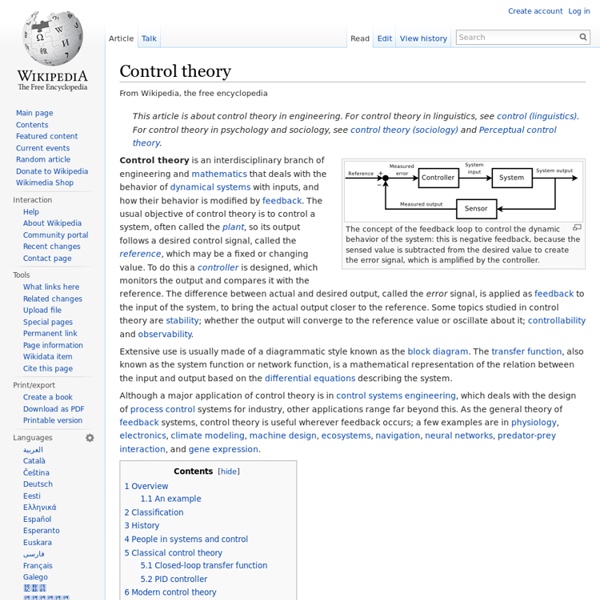PID controller
Some applications may require using only one or two actions to provide the appropriate system control. This is achieved by setting the other parameters to zero. A PID controller will be called a PI, PD, P or I controller in the absence of the respective control actions. PI controllers are fairly common, since derivative action is sensitive to measurement noise, whereas the absence of an integral term may prevent the system from reaching its target value due to the control action. History and applications[edit] PID theory developed by observing the action of helmsmen. The Navy ultimately did not adopt the system, due to resistance by personnel. Electronic analog controllers can be made from a solid-state or tube amplifier, a capacitor and a resistor. Most modern PID controllers in industry are implemented in programmable logic controllers (PLCs) or as a panel-mounted digital controller. Control loop basics[edit] The sensed water temperature is the process variable (PV). where : Error and . .
Jean-Jacques Rousseau
Jean-Jacques Rousseau (/ruːˈsoʊ/;[1] French: [ʒɑ̃ʒak ʁuso]; 28 June 1712 – 2 July 1778) was a Genevan philosopher, writer, and composer of the 18th century. His political philosophy influenced the French Revolution as well as the overall development of modern political, sociological, and educational thought. Biography[edit] Youth[edit] Rousseau was born in Geneva, which was at the time a city-state and a Protestant associate of the Swiss Confederacy. Rousseau was proud that his family, of the moyen order (or middle-class), had voting rights in the city. Geneva, in theory, was governed democratically by its male voting "citizens". There was much political debate within Geneva, extending down to the tradespeople. The house where Rousseau was born at number 40, Grand-Rue. The trade of watchmaking had become a family tradition by the time of Rousseau's father, Isaac Rousseau. He and his older brother François were brought up by their father and a paternal aunt, also named Suzanne.
Gain scheduling
One or more observable variables, called the scheduling variables, are used to determine what operating region the system is currently in and to enable the appropriate linear controller. For example in an aircraft flight control system, the altitude and Mach number might be the scheduling variables, with different linear controller parameters available (and automatically plugged into the controller) for various combinations of these two variables. A relatively large scope state of the art about gain scheduling has been published in (Survey of Gain-Scheduling Analysis & Design, D.J.Leith, WE.Leithead).[1]
Deadband
Input and output of the deadband operator. Voltage regulators[edit] In some substations there are regulators that keep the voltage within certain predetermined limits, but there is a range of voltage in-between during which no changes are made, such as, maybe, between 112 to 118 volts (deadband is 6 volts here), or 215 to 225 volts (deadband is 10 volts here). Backlash[edit] Gear teeth with slop (backlash) exhibit deadband. Hysteresis Vs. Deadband is different from hysteresis. Thermostats[edit] Simple (single mode) thermostats exhibit hysteresis. A thermostat which sets a single temperature and automatically controls both heating and cooling systems without a mode change exhibits a deadband range around the target temperature. Alarms[edit] A smoke detector is also an example of hysteresis, not deadband. References[edit] Johnson, Curtis D. See also[edit] Schmitt trigger
Stiction
Stiction is the static friction that needs to be overcome to enable relative motion of stationary objects in contact.[1] The term is a portmanteau of the term "static friction",[2] perhaps also influenced by the verb "stick". Any solid objects pressing against each other (but not sliding) will require some threshold of force parallel to the surface of contact in order to overcome static cohesion. Stiction is a threshold, not a continuous force. In situations where two surfaces with areas below the micrometer range come into close proximity (as in an accelerometer), they may adhere together. Automobiles[edit] Stiction is also the same threshold at which a rolling object would begin to slide over a surface rather than rolling at the expected rate (and in the case of a wheel, in the expected direction). This is why driver training courses teach that if a car begins to slide sideways, the driver should try to steer in the same direction as the slide with no brakes. Examples[edit] Biology[edit]



